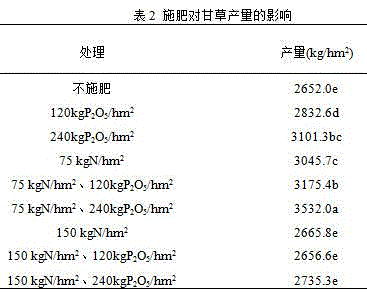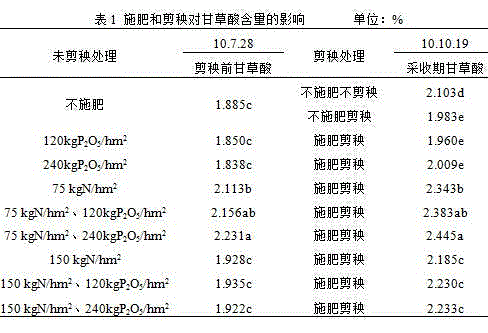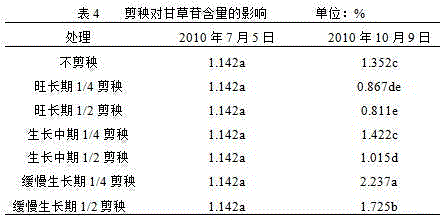Method for improving saline and alkaline land by glycyrrhiza uralensis nodule bacteria
A technology of licorice root nodules and saline-alkali land, applied in the agricultural field, can solve problems such as unsatisfactory, low content of licorice glycyrrhizic acid and licorice glucoside, affecting licorice quality and market sales, etc., so as to change microclimate, improve feeding value, increase yield and effectively The effect of ingredient content
- Summary
- Abstract
- Description
- Claims
- Application Information
AI Technical Summary
Problems solved by technology
Method used
Image
Examples
Embodiment 1
[0021] The cultivation of embodiment 1. Ural Glycyrrhizae comprises the steps:
[0022] A. Transplanting: Select annual licorice seedlings for spring transplanting, place the licorice seedlings at a 40-degree inclination along the opened ditch wall and place them in the same direction, bury the root head of the licorice seedlings 4 cm below the soil layer, and the root tail along the ditch Lay flat without bending; the distance between plants is 12cm, and the distance between rows is 30cm. Nitrogen and phosphorus fertilizers were applied at the same time; the cultivation density was 225,000 licorice plants / hm at one time in saline-alkali land 2 . The fertilization rate of nitrogen fertilizer is 75kgN / hm 2 , the amount of phosphate fertilizer applied is 240 kgP 2 o 5 / hm 2 .
[0023] B. Seedling cutting: Cut seedlings for the first time during the vigorous growth period of licorice, and cut off 1 / 4 of the plant height; cut seedlings for the second time during the deciduo...
Embodiment 2
[0025] Embodiment 2. The cultivation of Glycyrrhizae uralensis comprises the following steps:
[0026] A. Transplanting: Select the annual licorice seedlings for spring transplanting, place the licorice seedlings at a 45-degree inclination along the opened ditch wall and place them in the same direction, bury the root head of the licorice seedlings 5 cm below the soil layer, and the root tail along the ditch Lay flat without bending; the distance between plants is 15cm, and the distance between rows is 30cm. Nitrogen and phosphorus fertilizers were applied at the same time; the cultivation density was 225,000 licorice plants / hm at one time in saline-alkali land 2 . The fertilization rate of nitrogen fertilizer is 150kgN / hm 2 , the amount of phosphate fertilizer applied is 240 kgP 2 o 5 / hm 2 .
[0027] B. Seedling cutting: Cut seedlings for the first time during the vigorous growth period of licorice, and cut off 1 / 4 of the plant height; cut seedlings for the second t...
Embodiment 3
[0028] The cultivation of embodiment 3. Ural Glycyrrhizae comprises the steps:
[0029] A. Transplanting: Select the annual licorice seedlings for spring transplanting, place the licorice seedlings at a 35-degree inclination along the opened ditch wall and place them in the same direction, bury the root head of the licorice seedlings 3 cm below the soil layer, and the root tail along the ditch Lay flat without bending; the distance between plants is 10cm, and the distance between rows is 30cm. Nitrogen and phosphorus fertilizers were applied at the same time; the cultivation density was 225,000 licorice plants / hm at one time in saline-alkali land 2 . The fertilization rate of nitrogen fertilizer is 100kgN / hm 2 , the amount of phosphate fertilizer applied is 180 kgP 2 o 5 / hm 2 .
[0030] B. Seedling cutting: Cut seedlings for the first time during the vigorous growth period of licorice, and cut off 1 / 4 of the plant height; cut seedlings for the second time during the de...
PUM
 Login to View More
Login to View More Abstract
Description
Claims
Application Information
 Login to View More
Login to View More - R&D
- Intellectual Property
- Life Sciences
- Materials
- Tech Scout
- Unparalleled Data Quality
- Higher Quality Content
- 60% Fewer Hallucinations
Browse by: Latest US Patents, China's latest patents, Technical Efficacy Thesaurus, Application Domain, Technology Topic, Popular Technical Reports.
© 2025 PatSnap. All rights reserved.Legal|Privacy policy|Modern Slavery Act Transparency Statement|Sitemap|About US| Contact US: help@patsnap.com



